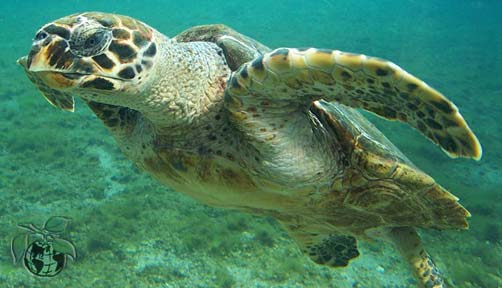. NATIVE WILDLIFE
Sea turtle, hawksbil

. Eretmochelys imbricata
Source link:
http://conservationoutdoors.org/species/eretmochelys-imbricata.htm
Common name:
English - Hawksbill Turtle
French - Caret, Tortue Caret, Tortue Imbriquée, Tortue À Bec Faucon, Tortue À Écailles
Spanish - Tortuga De Carey
Status
Eretmochelys imbricata or Hawksbill Turtle is classified as Critically Endangered (CR) on the IUCN Red List 2008.
Description
This marine turtle has been exploited for thousands of years as the sole source of commercial tortoiseshell. The beautiful carapace is generally streaked and marbled with amber, yellow or brown and often has a strongly serrated edge. Unlike other species, the scales (or scutes) of the carapace overlap. The narrow head and strongly hooked beak give rise to this turtle's common name, while the imbricate nature of the (overlapping) scutes give rise to the Latin species name of 'imbricata'.
Habitat
Hawksbills nest on insular and mainland sandy beaches throughout the tropics and subtropics. They are highly migratory and use a wide range of broadly separated localities and habitats during their lifetimes (for review see Witzell 1983). Available data indicate that newly emerged hatchlings enter the sea and are carried by offshore currents into major gyre systems where they remain until reaching a carapace length of some 20 to 30 cm. At that point they recruit into a neritic developmental foraging habitat that may comprise coral reefs or other hard bottom habitats, sea grass, algal beds, or mangrove bays and creeks (Musick and Limpus 1997) or mud flats (R. von Brandis unpubl. data). As they increase in size, immature Hawksbills typically inhabit a series of developmental habitats, with some tendency for larger turtles to inhabit deeper sites (van Dam and Diez 1997, Bowen et al. 2007). Once sexually mature, they undertake breeding migrations between foraging grounds and breeding areas at intervals of several years (Witzell 1983, Dobbs et al. 1999, Mortimer and Bresson 1999). Global population genetic studies have demonstrated the tendency of female sea turtles to return to breed at their natal rookery (Bowen and Karl 1997), even though as juveniles they may have foraged at developmental habitats located hundreds or thousands of kilometers from the natal beach. While Hawksbills undertake long migrations, some portion of immature animals may settle into foraging habitats near their beaches of origin (Bowen et al. 2007).
Distribution
The Hawksbill has a circumglobal distribution throughout tropical and, to a lesser extent, subtropical waters of the Atlantic Ocean, Indian Ocean, and Pacific Ocean. Hawksbills are migratory and individuals undertake complex movements through geographically disparate habitats during their lifetimes. Hawksbill nesting occurs in at least 70 countries, although much of it now only at low densities. Their movements within the marine environment are less understood, but Hawksbills are believed to inhabit coastal waters in more than 108 countries (Groombridge and Luxmoore 1989, Baillie and Groombridge 1996.
Population
Analyses of subpopulation changes at 25 Index Sites distributed globally show an 84 to 87% decline in number of mature females nesting annually over the last 3 Hawksbill generations. Numerous populations, especially some of the larger ones, have continued to decline since the last assessment of the species (Meylan and Donnelly 1999). Today, some protected populations are stable or increasing, but the overall decline of the species, when considered within the context of three generations, has been in excess of 80%.
Threats
Analysis of historic and recent published and unpublished accounts indicate extensive subpopulation declines in all major ocean basins over the last three Hawksbill generations as a result of over-exploitation of adult females and eggs at nesting beaches, degradation of nesting habitats, take of juveniles and adults in foraging areas, incidental mortality relating to marine fisheries, and degradation of marine habitats.
Conservation Efforts
International trade in the hawksbill turtle is banned amongst signatory nations by its listing on Appendix I of the Convention on International Trade in Endangered Species (CITES), but extensive illegal trafficking still occurs between CITES signatories and among other nations. Preventing this black market trade is the key to saving this species and TRAFFIC (the wildlife trade monitoring arm of WWF and IUCN-World Conservation Union) is involved in monitoring and highlighting this problem. In 1988, the government of the Seychelles took a very public stand against tortoiseshell trade by burning a stockpile of seized shells, in a manner reminiscent of burning ivory pyres in Kenya. Action to save the world's turtles is being taken by many international bodies and recent increases in hawksbill nesting populations have been observed at a few well-protected sites. With successful monitoring of populations and a decrease in illegal trade, the hawksbill may respond well to long-term protection.

|
SEA TURTLE CITES PROPOSAL RESEARCH.doc Size : 570.5 Kb Type : doc |